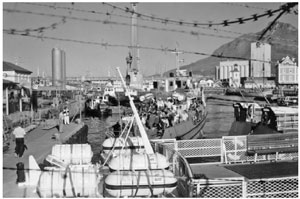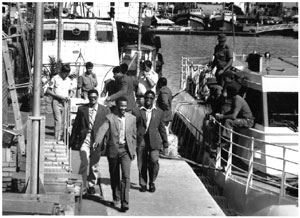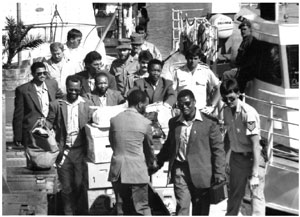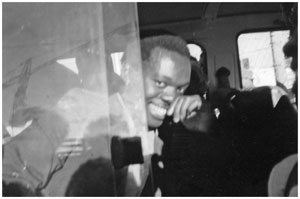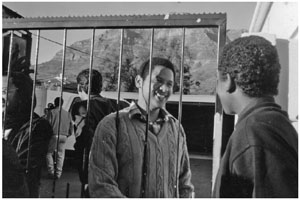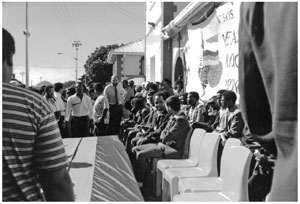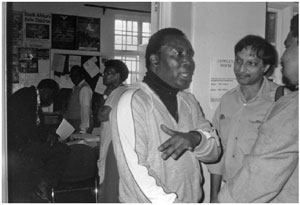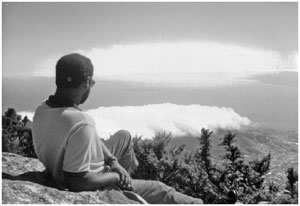Services on Demand
Article
Indicators
Related links
-
 Cited by Google
Cited by Google -
 Similars in Google
Similars in Google
Share
Kronos
On-line version ISSN 2309-9585
Print version ISSN 0259-0190
Kronos vol.34 n.1 Cape Town Nov. 2008
ARTICLES
Memories of a political prisoner on Robben Island, 1987-1991*
Cecyl Esau
History Department, University of the Western Cape / Institute for Justice and Reconciliation
I was arrested with a number of comrades in April 1986. I was charged with commtting acts of 'terrorism' against the apartheid state. Initially we were fifteen accused but two, Neville van der Rheede and Themba Tshibika, were not convicted. Thirteen of us were convicted and on 12 August 1987 sentenced by Justice Nel.
On the morning of 12 August 1987 we were escorted from Pollsmoor Maximum Prison, Tokai, just outside Cape Town, under heavy police guard with sirens wailing as the road was cleared. Inside the truck everyone seemed to be pre-occupied with his own thoughts. When we arrived in Cape Town we started singing freedom songs and kept this up until we got to the High Court in Keerom Street.
After waiting in the holding cells for some time we slowly made our way to the courtroom dragging our leg-chains. On entering the courtroom our families, comrades and friends erupted in song, Nank' uMkhonto uyangena.1 We were dressed in tracksuits especially made for us in the colours of the then banned African National Congress (ANC). My mother was standing in the front row in the gallery with a clenched fist salute. I felt intensely proud of her while reflecting on the journey we have travelled together to that moment in time.
Shortly after ten o'clock the court orderly called out 'stand up, silence in court' as the red-robed justice Nel entered. We did not rise in respect. Thereafter we all rose to be sentenced. Nel meted out severe sentences starting with life imprisonment for Lizo Bright Ngqungwana, followed by 25 year sentences for both Thembinkozi Mzukwa and Joseph Nogoma. When he sentenced Quentin Michels to 12 years I thought that I might get eight or ten years. However, Nel meted out the same sentence. After he sentenced Norman Siseko Macanda to three years he adjourned the court and left. There was a stunned silence in the gallery because the sentences were harsh. I urged my sister to lead with Hamba kahle Mkhonto. The court officials tried to hurry us out of court. We resisted. I looked at the crowd and held my fist high. Some of the people in the crowd were crying, wiping away tears.
As soon as we joined the highway en route to Pollsmoor Maximum there was silence in the van. Everybody was sunk in thought, reflecting on the meaning of those severe sentences. On arrival at the prison we went back to our communal cell and spent the rest of the day in relative quiet. The following day after breakfast a tailor, one of the sentenced prisoners, came to take our measurements for prison clothes. After about two hours he brought the olive green prison uniforms and then we were told to pack our belongings. When we enquired from the prison official where we were to be taken to, he declined to tell us. Soon leg irons arrived and we slowly made our way with our belongings to the reception area where we also handcuffed.
We were driven to the Robben Island Maximum Prison embarkation point at Jetty Five at Cape Town harbour. We boarded the Dias that ferried prisoners and prison staff to Robben Island. It was my first journey by sea and I suffered slight sea sickness. On arrival at Murray Bay at Robben Island a truck was waiting and we loaded our belongings on it, but we walked the short distance, about 500 metres, to the Maximum Security Prison. We were processed, i.e. we were assigned prisoner numbers. I was given 42/87 meaning that I was the forty-second prisoner who arrived in 1987.
We were taken to A-Section which served as the observation section for newly arrived prisoners. It consisted of a number of single cells with bucket toilets, a communal ablution block, and a classroom sized place that served as a dining area as well as a place for indoor activities. The yard was surrounded by a high security wall with a watch-tower. There was also a tennis court and an oil drum fashioned into a manual washing machine in the yard. The washing machine was angled at 45 degrees with a handle that was used to turn the drum.
I was called one late afternoon by an official who informed me about my father's death. On reflection then I realized that he did so humanely. He enquired whether I knew that my father was ill and I informed him that he had suffered for some time of cardiac asthma. He informed me that I would receive a visit from my lawyer, Ibbie Mohamed, and my sister June the following day. In a way I expected the passing of my dad as he was suffering for a long time. He did not attend our trial at the Supreme Court. The last time I saw was at one of the remand hearings in Hermanus or Malmesbury.
The following day I got my first visit on Robben Island. It was a contact visit which meant that we could have physical contact and that the visit was monitored by a prison warder. Only notch four prisoners were allowed such visits. Visits for prisoners up to notch three was conducted in visitor cubicles and through a plastic pane with communication conducted via a telephone.
I applied to attend the funeral but that was turned down. Two weeks later I received photographs of my father's funeral. It only struck me then that I will never be able to share my prison experiences with my dad who had a profound impact on my interest in politics.
Shortly after my arrival at Robben Island Bushy Maape and Jama Matakata, whom I had met previously, dropped in to greet me. I met Bushy in 1983 in Kuruman as a organizer for the United Democratic Front (UDF) and Jama as a youth activist from Paarl. I was happy to see some familiar faces.
My stay in the observation section was punctuated with a few interesting incidents. On arrival there some of the Durban 12 trialists like Vejay Ramlakan, Sibongiseni Dhlomo, Qonda, Bafo and Lulamile Xate who were there still in the section. We were introduced to lunch-time political classes that consisted either of an analysis of newspaper reports or the discussion of topical issues. Newspaper reports and political notes at the time came in the form of impukani.2 At the time the political class dealt with the early history of the ANC, more specifically whether the ANC was a reformist or revolutionary organization right from its outset. I argued that at best it was a reformist organization at the time as it sought to be accommodated within the constitutional framework of the day. It even accepted the educational, income and property franchise qualifications. Moreover, the organization consisted by and large of chiefs, priests, teachers and other middle-class elements with no organized presence of working people or peasantry. These arguments elicited spirited contestation. The main argument presented was that the mere coming together of Black Africans in 1912 to establish a national political formation was revolutionary.
An incident took place not long after my arrival at A-section. On a weekday after we were locked up for the night two prisoners arrived. One was clad in olive green prison uniform and the other in civilian dress. The following morning I was introduced to Castro Leholo from George and a fellow from the Eastern Cape,3 whom I shall call Mr A. I introduced myself to them and Mr A told me that we had met before at Denchworth Road Belgravia, Athlone in 1985. He impressed on me that he knew who my friends were and was keen to find out about the whereabouts of a key activist with whom I shared the Denchworth Road house. Later that day I was asked by the political structures in the section to obtain as much information as possible about Mr A. His arrival in civilian clothes whilst Castro was in prison uniform had raised the suspicion about him. He told me that he had also studied law at UWC. Now I was a veteran law student from UWC. I promptly asked whether he had done one of my favourite subjects, Latin. Incidentally I passed Latin I with the University of South Africa (UNISA) the following year. When he told me he also did Latin I asked him to conjugate amare, to love.4 He could not and immediately my suspicion was aroused. For the next couple of days he set out to find out about our underground network to which I belonged in Cape Town. When I tried to find out about his activities, those that gave rise to his imprisonment, he was very vague. He was from the Eastern Cape but operated in the Mossel Bay and George area. Eventually I reported to the structures that Mr A was suspect and that he should be closely monitored. About a year later he confessed to senior comrades in G-section that he was indeed an informer.
After about two months in A-section some of my comrades were transferred to the general sections. Lizo Bright Ngqungwana was the only one transferred to B-section where the Rivonia trialists and later other leadership figures were kept. A few of my co-accused and I remained in the Observation Section. By Christmas 1987 a number of prisoners have joined us and after a couple of weeks were transferred to the general sections. Mr A also stayed behind with us. The situation became intolerable. We resolved in the new year to find out from the prison authorities why we could not be transferred to the general sections. One morning Major Stassen came to our section on inspection enquiring about our requests and complaints. I was tasked to ask him when we would be transferred to the general sections. He responded by saying that Pretoria 5 had to authorize our transfers. I promptly expressed my disbelief and then he retaliated by responding that if I did not want to believe him then I should speak to the wall. At which point he turned on his heels, followed by a retinue of officers.
Our next course of action was to clean our cells and sweep the dirt into the passage. Prison officials had to walk the passage on their way to the kitchen, through to the yard where we spend most of our time. After a few days the dirt had accumulated in the passage. Whilst I was having breakfast in my cell on the Saturday after we had started our action, Major Stassen came around to me, giving me a very friendly greeting. I responded to his greeting by telling him that he should greet the wall because he told me previously that I should speak to the wall if I did not want to believe him. He assured me that we would be transferred to the general sections by the following Monday. I warned him that if we were not transferred by the following Monday we would cause mayhem in the section. Needless to say, we had very limited options to cause them any inconvenience. By mid-morning on that Monday we were indeed transferred to the general sections. I was transferred to E Section.
D and E Sections were used to house prisoners who were graded notch two and three. This meant that those prisoners did not have access to newspapers and contact visits. Furthermore, they were not eligible to apply to work. When I arrived in E Section only two of the three communal cells were used. The communal cells consisted of a rectangular dormitory with a number of steel double bunks and a few tables. Closest to the entrance were the ablution facilities. Outside the section was surrounded by high security walls on three sides with two gates connecting the section to the kitchen area and the other to the general concourse. Opposite the entrance to the cell-block was a double high security fence with a gate that provided access to a sports field. At night to secure the Section a guard dog patrolled the double security fenced area.
Sometime towards the end of the year in 1987 I was summoned to the censor's office. On arriving there I was told to wait. I was waiting on the top of the staircase when Lieutenant Frans Mostert and Warrant-officer Nortje arrived. When Mostert was about half way up the staircase I told him that I was expecting his visit. I, of course did not but that remark caught him off-guard. He wanted to know why I had made that remark. I replied that many developments were taking place in Cape Town. Once seated in the office he proceeded to interrogate me about my relationship to a number of detainees who were later the accused in the Ashley Forbes Trial. I denied knowing them. Mostert's response was that they had told him that I had recruited them into the ANC MK underground structures. He further alleged that my fiancée at the time, Patricia Smit, who was also in detention, had admitted that I have given her letters to pass on to Nicklo Pedro, then also a detainee. I had not known until then that Patricia was detained but I denied ever giving her a letter to pass on to Nicklo. I then changed the topic and told him that I did not consider myself under any obligation as a sentenced prisoner to answer any of his questions and if they were still in power on the day of my release on 11 August 1999 he could put those questions again to me. I once more switched the topic of conversation to ask him whether he would serve under an ANC government thus interrogating him in the same way as I had whilst a detainee in 1986. He became upset, telling me that he was not there to discuss politics and he got up in a huff and left.
At E Section I started to get to know life on Robben Island differently. What accounted for this was the fact that prisoners stayed for relatively long periods in the section after their transfer from the observation. In a sense they led a relatively settled life-style. The routine here was very different to that in the Observation Section. On week days breakfast was served at 07h00, lunch by 12h00 and supper by about 16h00. During the morning session some prisoners would be studying whilst others might be washing their prison clothes. During this period one might also be summoned to get onto a 'taxi'. This term referred to a prisoner being invited to a walk around the sports field accompanied by usually one or two fellow prisoners to discuss particular sensitive issues whether political, private or personal. In this way confidentiality could be assured and eavesdropping eliminated.
After lunch a political class was usually conducted for an hour directed by the political commissar of the cell. Thereafter I would take a siesta. During the afternoon session I would do some research if I were assigned to collect information. The research process entailed that I had to consult older cadres to canvass particular issues with them. I had registered as a law student with UNISA and devoted at least a couple of hours per day to my studies.
I was eager to explore the rest of the prison. Movement in the prison however was limited to the hospital section, to the study office and, if one had a visit, to the visitor section that was close to the harbour outside the prison section. Invariably movement outside the section was monitored by the warder on duty who would accompany the prisoner. Not long after my transfer to E Section I asked Major Stassen to be allowed to spend an hour a day during the week with Jama Matakata in F-section to study together as we were doing the same course. He turned it down, asking why I chose a course that I could not master on my own!
On Saturdays there was always excitement in the prison because it was a sports day. Sports teams from the different sections were allowed to play against one another, usually on the soccer field next to G and F Sections. Soccer was the most popular sport. The sports and recreational activities were organized by a body established by the inmates across political affiliations. Funds were collected in South Africa and abroad to buy sporting and recreational equipment.
During the month of December the Sports and Recreation Committee usually organized Summer Games. Inmates were divided into different teams competing in soccer, rugby, tennis, table tennis, volley ball, athletics (track and field events), and chess.
On a weekly basis the record player would rotate to the different sections, the general sections, D, E, F and G, the hospital and, B Sections. Inmates could request a number of long playing vinyl records from a hand-written catalogue. My favourite request was a record of a reggae artist Eric Donaldson's song Freedom Street, my favourite line being 'Even the prisoners got to be freed'.
Friday afternoons were always filled with raised expectations to either receive a letter and or a notice of a visit over the week-end. If neither happened, dejection would be written large on the inmates' faces and they would retire early to bed. Each prisoner was accorded a limited number of letters and visits per month according to his grading. The majority of inmates were not from Cape Town or its surrounds, the result being that many did not receive regular visits from their relatives. Receiving notification of a visit was no guarantee that a visit would indeed take place.
On Christmas Eve 1989 I received a notice that on Christmas Day I would be visited by my aged mother and my sister. After lunch I got dressed in Lassy Chiwayo's neatly pressed olive green pants and shirt and I went to the hospital section to visit my friend Bushy Maape who stayed there. The hospital section was close to the censor's office that coordinated and monitored all visits. The Captain saw me there whilst on an inspection tour of the prisoner and enquired why I was there. I informed him that I was on my way to a visit and that I had thought of spending time with a longtime friend whilst waiting to be called for the visit. However, he was adamant that I had to wait in my section till I was called for the visit. I refused because I regarded his instruction as petty. In the end I was not allowed to have my visit with my mother and sister, instead I was locked up in C Section as punishment for disobeying the Captain's instruction to wait in my section to be called for the visit. I was fuming at being denied that visit and swore at the Captain and warders. After about two hours he and the warders released me from C Section. He said that I was fortunate that he was in a good mood because of its being Christmas Day and that I could go back to my section. On arriving back at the section I was informed that all the inmates of E Section refused to be locked up unless I was returned to the section! In addition, according to a number of the inmates, the Captain was drunk on duty. I seized upon that fact and drafted letters to my lawyer, the head of the prison as well as the commanding officer charging that the Captain was drunk on duty and hence could not fairly exercise his discretionary powers and had therefore acted unreasonably by denying me my Christmas visit. With that I set the cat amongst the pigeons!
The following week I was called to appear before a grading committee. The committee proposed that I be promoted to notch three entitling me to more visits and letters. In addition to that they would arrange a contact visit with my mother and sister in exchange for my withdrawing the letters to my lawyer and the prison officials. At that stage I was notch two because I had been demoted on a previous occasion from notch three. Shortly after the arrival of Ashley Forbes and his co-accused, whilst they were still in the Observation Section, I had managed to slip into A-section. I spent a few hours lying under a bed in one of the cells hidden by an overhanging blanket. Unfortunately, the warder must have noticed the comings and goings of people from that cell and investigated. I was hauled before a grading committee and demoted.
I decided to bargain with the grading committee. In exchange for withdrawing the letters I wanted to be promoted to notch four. In support of that position I argued that I wanted an end to what I perceived to be harassment by the authorities. I cited that I was kept for about six months in the Observation Section whilst my co-accused had spent far less time there. Furthermore, I had been demoted on account of what I considered to be a minor infringement of prison rules. Finally, I emphasised that the Captain's arbitrary action on Christmas Day to deprive me of a visit by my mother and sister was capricious. After some discussion amongst themselves, the committee resolved to promote me to notch four. I had to write a letter withdrawing my correspondence to my lawyer and the prison officials.
On New Year's Eve 1989 we held a variety concert in our cell. A stage was organized in the middle of the communal cell. 'Maradonna' Shezi from Kwa-Zulu Natal and I performed a song from Lloyd Webber's Evita to an appreciative audience. The following year's New Year's Day variety concert was a much grander concert.
Early one morning in October 1989 a warder came to our communal cell and instructed me to wash and get ready to go the mainland. I did not have an appointment at the hospital and was at a loss why I had to go to the mainland. He told me that also did not know. When I got to the reception area fellow inmates Tom Manthata, Popo Molefe, Nceba Faku, and Comrade Mfenendala were also there. They also did not know what was happening. We were taken by ferry to the mainland. Not long after we had arrived we got into a kombi and were driven along the N1, the national road to Johannesburg. We realized that we were on our way to Paarl.6 Comrade Nelson Mandela was held at the Victor Verster Prison.7 On realizing that I was about to meet one of the most celebrated leaders of our national liberation struggle I could scarcely suppress my excitement.8
We arrived at the house where Mandela was kept and we could hardly restrain ourselves. Amongst our party Comrade Mfenendala from Pietermaritzburg was the only one who knew Mandela from his time at Robben Island. Mandela enquired after my mother and extended condolences on the passing of my father. He was obviously informed about our family situations. After some tea and scones served by one of the prison staff members he informed us about his interactions with officials of the apartheid government. Later we went outside where he briefed us on his contact with the ANC in Lusaka. He reiterated to us that he was not involved in negotiations with the apartheid government and that was the responsibility of the ANC in Lusaka. At lunch he offered us drinks. However, only comrade Mfenendala and I accepted whisky with ice, the others declined. I could not pass up the occasion by refusing such an offer from Mandela.9 Shortly after lunch we were on our way back to Robben Island. My most enduring image of that visit was when we were sitting in the kombi and he was standing tall dressed, in olive green pants and shirt with a blue jersey holding a fist aloft. It was an image millions of people dreamt of seeing.
One day in 1990 I got an opportunity to explore a little bit of the Island when volunteers were sought to clear seaweeds from a section of the beach. Some of the prisoners who had done this before brought pieces of wire with them. These were lowered into pools to catch crayfish. At that time we were allowed two-plate stoves and the crayfish were cooked. Despite crayfish being a sought-after delicacy for some, not many inmates from the interior found them palatable - to our advantage.
At the opening of parliament on 2 February 1990 FW de Klerk lifted the ban on a range of organizations including the African National Congress and the Pan Africanist Congress of Azania. He also announced the release of political prisoners and, that Nelson Mandela would be released nine days later. Heady days of making sense of those developments followed, accompanied by speculation on how life outside prison would be: these issues made up virtually every discussion. The climax was, of course, the release of Nelson Mandela on 11 February from Victor Verster Maximum Security Prison. We held a placard demonstration on the sport-field at G Section, demanding the release of all political prisoners. Then the long wait started. Johnny Issel, my political mentor and 'political commissar', visited me a few days before the release of Mandela. He shared with me his contention that the return of Mandela should herald the beginning of the end of the apartheid state, like the return of the Ayatollah Khomeni from Paris when one million people lined the road from the airport in Teheran. Johnny's views, however, did not enjoy any support amongst the political leadership at the time.
The release process was slow because the apartheid government used the release of political prisoners as one of its bargaining chips during the pre-negotiations with the ANC. Relatives and others started a campaign in Cape Town to demand our release by chaining themselves to the gates of Parliament. On the Island we also embarked on a hunger strike that drew even greater support.
Life on the Island changed drastically for me. Free movement in the prison was the norm. We could subscribe to any newspaper in the world and received so many newspapers locally, nationally, daily, and weekly and some from abroad like the Granma and Moscow News. Following years of newspaper censorship this was quite a bewildering and overwhelming experience. Everybody could get a FM radio, I do not know why or whether shortwave radios were disallowed. Listening to shortwave radio stations had been one of my hobbies since Std. 5 (Grade 7) and at the time of my arrest I had a digital Sony shortwave radio that gave me access the radio stations of liberation movements like the ANC's Radio Freedom, amongst others. Each communal cell was also provided with a television set. Slowly the political classes became less important. Political structures, however, were maintained.
Sometime during the latter half of 1990 I requested to move to A Section which was a single cell section. I needed some space to myself and to get away from the constant bickering about which television programme to watch. In any event I was an avid radio listener. Soon I was followed by other inmates that sought peace and quiet. We were also allowed to place monthly orders for fruit and vegetables. I enjoyed inviting friends for breakfast that consisted of toast, avocado and tomato sandwiches with coffee.
Lizo Bright Ngqungwana stayed in B-section that was also a single cell section and received a special diet that included rice on account of his health. Some time in 1990 Lulamile Xate and I would have an extended lunch with Lizo in his cell. I met Lulamile at A Section in 1987. He had refused to testify in a political trial in Durban. At the time of his arrest he was a senior student in medicine at Natal University. Those extended lunch discussions provided ideal opportunities for exploring our personal journeys and future ambitions. In addition, I enjoyed friendships with a range of comrades from the Free State, Mpho Ramakatsa and Lucky Selekoe and from Natal such as Vincent James, Sihle Mntongwa, Vejay Ramlakan, from Mpumalanga, Lassy Chiwayo and his co-accused.
The last visit I received on the Island was on 18 February 1991 from my sister and Jeremy Veary. On my way to the visitor section Clement Baadjies, who was returning from a visit, asked me whether it there was any truth in the rumour that Quentin Michels and I were to be released later that week. I was taken aback by that - it was the first time that I heard about it. June and Jeremy posed the same question to me. By then I could scarcely suppress my excitement. Back at the prison, I was called aside at the reception area. I was told to wait and not to proceed to my section. An officer came to inform me that I would be released later that week. I burst out laughing - by then I had served a little more than three-and-a-half years of my 12-year sentence.
I went straight to Lizo and informed him about the news. He told me that that was an indication that his release was also not far off. I promised him my computer chess set because I told him that he had to occupy himself till his release. I did not feel sad at leaving any of my friends and comrades behind because I knew in due course all of them would be released.
Late in the morning of Thursday, 21 February, Quentin Michels, Sazi Veldtman, Douglas Myamya, Junior Mkampe, Nazeem Lowe, Maboy Collin Ndevu and I boarded the Susan Kruger berthed at Robben Island's Murray's Bay and arrived at Table Bay harbour to a tumultuous welcome. We were reunited with our families, friends and comrades and then taken to Cowley House for a debriefing and media conference. Quentin Michels and I were afterwards taken to Bonteheuwel and were driven on board a horse-drawn cart along the main roads.
Since my release I had two stints working for the ANC: first as the head of the Organising Department and then during the first democratic elections I coordinated the canvassing work amongst farm-workers in the province. Following the victory of the ANC many of my former co-accused joined the armed forces whilst I continued to work in the NGO sector.10 I believed that working in civil society I could make a meaningful contribution to the social reconstruction and development of South African society.
ACCUSED NO. 11 CECIL11 ESAU - CAPE HIGH COURT, JUNE 198712
My Lord, I was born on 30 September 1955 in Worcester and am the youngest of four children. My mother and father are 73 and 68 respectively.
My father is a veteran of the Second World War and that experience had a profound influence on his life. His interest in politics was sparked by what he had observed in various African countries. He was indeed the first person who had kindled an interest in politics in me. For instance, he would buy English language newspapers regularly and read them to us. We would also have regular discussions about current affairs and subsequently I became an avid listener to current affairs on the radio whilst still at primary school. In fact, when I was in Standard Five I started to listen to broadcasts on shortwave and today it is one of my hobbies.
During the first elections for the Coloured Representative Council (CRC) in 1969 my father canvassed for the Labour Party candidate on the platform, 'A vote for Labour is a vote against Apartheid'. When pamphleteering he took me along. At that time I did not grasp everything but found the activities, like going to political meetings, very stimulating.
It was only about three years later when some friends and I started a discussion group at high school which concentrated mainly on political affairs that I developed a keener interest in politics. At about the same time I joined the Labour Youth Organisation. The following year, 1973, I was elected the branch secretary. One of the activities during that year which broadened my political outlook was my involvement with students from UWC [University of the Western Cape] who had staged a walk-off from campus. I assisted them in collecting signatures and attended numerous mass meetings in Worcester and the surrounding towns to demand their unconditional reinstatement. The response we received from the people and their perceptions of the political situation in our country made a lasting impression on me. It was clear to me that the vast majority of the people were vehemently opposed to the apartheid system but had yet to realise how to fight that system.
During my final year at school, 1974, I met John Marinus Ferrus, commonly called Hennie.13 At that time he was still a banned person. During the sixties he was an active member of the Congress Movement and served a couple of years on Robben Island for offences against the state. He commanded widespread support in Worcester and surrounding areas for his uncompromising stand against apartheid which caused untold suffering. Also, he kept the flame of the Congress alive. One important truism he taught me was that there are many things one wants to do but cannot do, and one often fails to do the things which one can. In short, this meant to me however lofty and inspiring dreams may be one should at all times be pragmatic in tackling the problems of the day. Furthermore, his shining example as a people's leader who was always at the forefront in confronting injustice despite continued police harassment, made a lasting impression on me. He also awakened my interest in the political history of Worcester and surrounding towns.
In 1974 I matriculated at Esselen Park High School in Worcester and obtained a university exemption. The following year I registered as a B.A. (Law) student at the University of the Western Cape. I participated wholeheartedly in various student organisations and was eventually elected the General Secretary of the SRC in 1977.14
During the national student uprising in 1976 I became aware that the students from the oppressed community, being more critical, had an important role to play in making other layers of our society more aware of the injustices in our land and the need to transform our society into one free from apartheid and exploitation.
It was also during the momentous events of 1976 that I was detained for the first time. I was held for four-and-a-half months in preventative detention.15 During this time I reflected a lot on the nature of our society and the injustice of detention without trail. As a law student at the time I was profoundly disturbed by the fact that a person's freedom could be curtailed without even having committed a crime.
In 1980 I again spent five-and-a-half months in preventative detention.16 The insensitivity of the state was forcefully demonstrated when the mother of a fellow detainee died but he was denied the opportunity to pay his last respects to her.
However, the most brutal cruel fact which stuck in my mind of in relation to 1976 and 1980 was the brutal killings of unarmed, defenceless children, women and students. It dawned upon me that the South African state was based on violence and was being maintained by it. Towards the end of 1985 I was detained at Victor Verster Prison for about thirty days in terms of the Emergency Regulations. On one occasion I exchanged some harsh words with a warder for which I was subsequently charged with crimen injuria and common assault.
I spent a lot of time during the years reading and studying about liberation struggles, particularly in Vietnam, Southern Africa and Latin America. What fascinated me about the people of those countries was their determination to be free from exploitation and oppression and their ultimate triumph over a seemingly invincible enemy. Another fact about those countries was the brutal repression by the regimes and their unwillingness to negotiate with the representative of the people. It was abundantly clear to me that no ruling class will ever willingly relinquish power. But perhaps, this was most eloquently stated by Ian Smith, the then Prime Minister of Rhodesia when he said 'majority rule, not in a thousand years, over my dead body'. Ironically he was to witness the birth of Zimbabwe and participated until recently in Parliament together with his enemies. Tragically, it seems true that the ruling classes never seem to learn from history.
During 1981 I decided to work for a community work agency.17 I began working in a more systematic way in organising people into civic associations and youth groups in Worcester. It was clear to me after the traumatic experiences of 1976 and 1980 that the oppressed people needed to be organised and mobilised around bread and butter issues and to address the national political situation as a united people.
In 1983 I became a founder member of the Cape Youth Congress (CAYCO) whose aim is to harness the tremendous resourcefulness and courage of youth to conduct struggle at all levels.
The launch of the United Democratic Front on 20 August 1983 in opposition to the tri-cameral system, community councils and forced removals raised my expectations about fundamental changes in our society. In short, my rejection of the tri-cameral system was based on the following:
1. It was undemocratic in that the vast majority of our population in S.A. was excluded and coupled with that, it perpetuated the policy of divide and rule.
2. The constitution of the tri-cameral parliament made it clear that the ultimate legislative power was still in the hands of the National Party despite the trappings of 'power-sharing'.
3. Ostensibly it set out to do away with apartheid but the constitution is shackled to race.
During 1983-4 I worked as a rural organiser for the UDF in the greater part of the Cape Province. It was a period of immense enthusiasm and increased political expectation. My main tasks were to initiate contact in various towns for the UDF, to establish organising committees, and to set up regional structures. The support for the stand of the UDF in the rural areas was tremendous. The people grasped the difference between the former anti-apartheid stand of the Labour Party, which became a junior partner to PW Botha in the tri-cameral parliament, and the united, non-racial and democratic S.A. for which the UDF is struggling. The vast majority of our people did in no unmistakable terms declare their utter rejection of the apartheid state on 20 August 1984, election day. Unfortunately, I could not witness the defiant stand they took in the face of large-scale intimidation by the state and the clamour from those who urged them to submit to white supremacy, because a friend and I were arrested two days before polling day in my hometown of Worcester on a spurious charge of putting up posters without the necessary authority.18 We were eventually found not guilty. The intransigence of the government to heed the democratic voice of the people plunged me into the depths of despair. I eventually resigned as a rural organiser of the UDF and experienced immense political frustration.
I discovered that quite a number of my comrades in the Cape Youth Congress (CAYCO) were going through the same frustrations. Initially, we would raise the issue when we bumped into one another. Later, however, we decided to formalise the process and rigorously evaluated what was to be done about the seemingly granite wall of apartheid and exploitation. For example, we read extensively about the struggles of our people since the day the white settlers arrived here at the southernmost point of Africa19. We also complemented this with theoretical matters like the nature of our society and struggle, and intense debates about strategies to apply in order to bring about fundamental changes in our country.
I, like many comrades in the discussion group, was faced with the dilemma: it was clear that legal, peaceful resistance to apartheid had come to a dead end. On the other hand, the ruling class could only maintain the status quo because it had the monopoly of fire power.
The dilemma we as a group faced then is indeed the dilemma and challenge of every young South African. That is one challenge which we were willing to accept, one which we were unwilling to postpone, and one we intended to meet. We were further encouraged by the words of one of the most celebrated of South African poets, N.P. van Wyk Louw, in his Lojale Verset (states): 'dis nie 'n skande as 'n rebellie misluk nie, maar dis 'n skande as een geslag sonder rebellie verbygaan'.20
I, together with my comrades in the discussion group, decided to answer the call of the African National Congress (ANC), 'every patriot a combatant, every combatant a patriot'. My decision then, to assist the ANC, was grounded in a profound sense of patriotism and the profound desire to rid the fatherland of the apartheid system and exploitation.
I concede that my decision was a grave one, but then again the history of South Africa is studded with illustrious examples of resistance and struggle against oppression of which the Afrikaner volk is a prime example.
My comrades and I did not have any illusions that the road we embarked upon is an easy one. However, there is no middle road between racist oppression and exploitation and resistance and struggle. We believed firmly that 'the armed struggle is the continuation of the political struggle by other means'.
I decided to assist the ANC for the following reasons:
1. Its programme, the Freedom Charter, enshrines the aspirations of the majority of South Africans as a first step to establish a truly non-racial democracy
2. It enjoys the largest support amongst all the forces opposing the apartheid state
3. It has shown during its 75 years of existence to be the only movement capable of seriously challenging the hegemony of the present ruling class.
'The people's patience is not endless. There comes a time in the life of every nation when there remain only two choices, submit or fight, and we have no choice but to hit back by all means within our power in the defence of our people, our future and our fatherland.'21
The people's non-violent policies have been taken as a green light for Government violence.
Future happiness and well-being cannot be attained without the overthrow of the Nationalist Government, the destruction of the apartheid state and the establishment of a truly non-racial, democratic undivided South Africa.
Long live the ANC and NDS!!
Forward we advance with People's Power!!
Moments in the journey of release from Robben Island
This photo essay narrates the different moments in my journey of release from Robben Island. The process of release is punctuated by instances of fettered interaction, such as contact with the public being controlled by fences, being transported from the harbour by kombi, the gate at Cowley House and at the media conference.
1
ON BOARD THE DIAS TO FREEDOM
(Photo: Cecyl Esau)
It seems the ferry takes ages to dock. Former prisoners on board strain their eyes to make out faces among the assembled welcoming crowd kept out by the razor blade fence. The excited crowd awaits the docking of the boat and can hardly restrain itself. I remember that on the day I was released, 21February 1991, as we were approaching the quay, I saw a large group of people assembled. At first I did not realise that they had come to welcome us back. I scoured the crowd for familiar faces and saw my mother smiling broadly. People were shouting my name.
I took this photograph during March 1991. It shows the Dias coming in to dock at Jetty Five. On board are a number of prisoners who have just been released from Robben Island. In the foreground of the picture the upper deck of the Susan Kruger is visible. This ferry was named after the wife of a former Minister of Justice, Jimmy Kruger. In the background in the top right of the picture part of Table Mountain is visible. Across the top of the photograph is a safety fence signifying a protective device used to keep unauthorised persons out.
2
MY FREEDOM DAY
(Photo: Benny Gool)
This photograph was taken by Benny Gool on 21February 1991 when I was released from Robben Island. We were ferried to the mainland by the Susan Kruger to the right in the picture. A number of warders on the ferry look curiously on. Three former prisoners are walking towards the crowd of relatives and well-wishers: Sazi Veldtman, Quentin Michels and Junior Mkampe. They were in a hurry to be reunited with family members and friends.
I called the three comrades back to lend a hand with loading our luggage onto the trolley. I am partially obscured by Nazeem Lowe in the middle of the picture. Slightly behind Junior, wearing sunglasses, Douglas Myamya standing akimbo looks on.
I concentrated on the task at hand loading our belongings onto a trolley and was assisted by Nazeem Lowe.
Many prisoners on the Island had to wear sunglasses or tinted glasses because of the glare. Not only are the eyes shielded from the harsh light but it also masks true feeling. Incarceration was not always easy to cope with.
3
FREEDOM IS A BIG SMILE
(Photo: Benny Gool)
This photograph was taken by Benny Gool on 21 February 1991 when I was released from Robben Island Prison.
The trolley, stacked with Kromco apple boxes, is pulled by Sazi Veldtman and Junior Mkampe. These apple boxes contained the belongings of former prisoners. The belongings consisted mostly of books and other items. Robben Island Museum later developed the Apple Box Project, was a travelling exhibition which took the experiences of political prisoners to people who could not visit Robben Island.
I am walking behind the trolley. I am wearing tinted glasses and am carrying a bag in my right hand. Although I am looking down a broad smile can be seen on my face. I am looking down because I easily trip over objects because I had polio as a child.
FM radios were prized possessions in prison. However, it was considered a privilege to have one, not a right. Radios were only allowed some time during the 1980s. The news on the FM radio stations were heavily controlled by government. Prisoners enjoyed listening to the music and sport programmes. Junior is taking the FM radio home, not to listen to it, because as a free person he could access a wide range of local and international radio stations. The FM radio will serve as a memento of his Island experience.
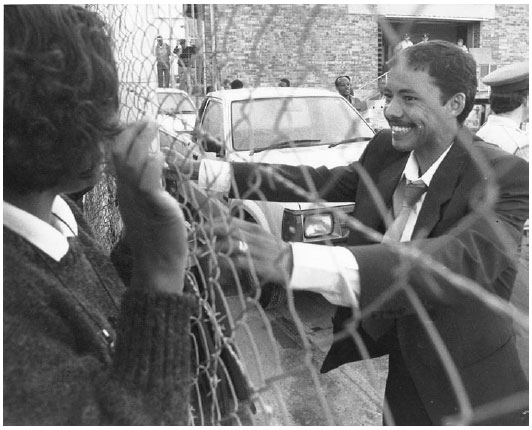
4
FREEDOM - SEPARATED BY A FENCE
(Photo: Benny Gool)
This photograph was taken by Benny Gool in May 1991. This image is of Ashley Forbes, a former Robben Island prisoner greeting family and friends with an expression of utter joy and exuberance. They are separated from each other by only a wire fence. He is moments away from being free to embrace them unhindered. He is dressed in suit and tie. In the middle of the picture, partially obscured by the bakkie is Ace (surname unknown) carrying his belongings in apple boxes.
The process of release is punctuated by a number moments of gradual, controlled interaction.
Forbes'elation at seeing family members and friends is not constrained by being separated by the fence. His having sighted them transforms his being and he reaches out, straining to touch them. His expression of joy is sharply contrasted with Ace's facial expression of studied pre-occupation with carrying his belongings packed in apple boxes.
An illusion is created in the photograph in that it seems that the woman on the left side of the photograph is not the one at whom Forbes'attention is directed. His attention is directed to someone else, possibly his wife, Yasmina, next to her.
5
ON HIS WAY TO NEWCASTLE, KWA-ZULU NATAL
(Photo: Cecyl Esau)
I took this photograph in 1991 when Thembinkosi Nkosi and others were released from Robben Island. He is seated in a kombi to be transported to Cowley House in Chapel Street which served as the reception centre for released prisoners. He leans slightly forward when I called him wearing a bemused smile slightly covering his mouth with his left hand.
Thembinkosi was tragically killed on the 16 December 1991 in Mdadeni, Newcastle during the then on-going strife between Inkatha and the ANC.
6
COMRADES REUNITED
(Photo: Cecyl Esau)
I took this photograph in May 1991 when Nicklo Louis Pedro, Ashley Forbes and others were released from Robben Island. The former prisoners have disembarked from the kombi and some have rushed to the gate to greet family, friends and comrades. Nicklo warmly greets his friend and comrade, Clement Baadjies, who was released before him from Robben Island. His right arm is thrust through the gate separating them for the moment The woman at the bottom left is Yasmina Pandy, wife to Ashley Forbes who has his back to the gate and is moving into Cowley centre to be processed.
Warmth and energy is reflected in the exchanges between Nicklo and Clement and are evident on their faces. Even though Clement's face is partially not visible it is clear from the left side of his face that he shares Nicklo's excitement and joy.
7
PREPARING FOR THE MEDIA CONFERENCE
(Photo: Cecyl Esau)
I took this photograph in 1991 when Anwa Dramat, seated in the front row nearest to the camera, and others were released from Robben Island. He is seated next to the late Chris Hani, leading member of the ANC and MK. The scene is set for a media conference that is about to begin. Trevor Manuel is in the centre of the picture moving to take up his seat in the front row. To the right of Hani, slightly obscured is the bespectacled face of Vejay Ramlakan who, together with Sibongiseni Dhlomo released earlier, were qualified medical doctors at the time of their imprisonment.
Anwa, from Bonteheuwel on the Cape Flats, was elected to read a statement to the media on behalf of the released prisoners. He was chosen probably because he was considered a 'familiar'face from the Western Cape.
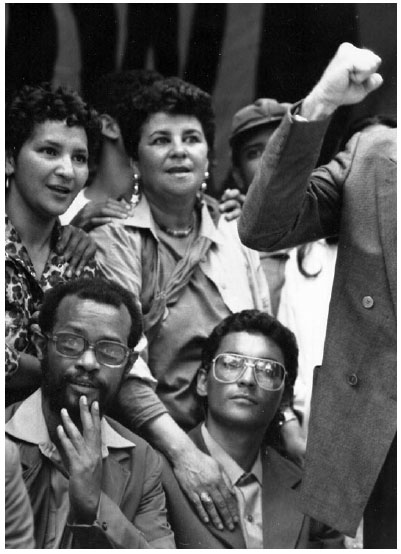
8
AT THE MEDIA CONFERENCE
(Photo: Benny Gool)
This photograph was taken by Benny Gool on 21 February 1991 when I was released together with Nazeem Lowe, seated on my left. Sazi Veldtman gives a clenched fist salute on the right side of the picture. We were presented to the assembled crowd and media at Cowley House. Nazeem is lovingly touched by his mother, Fowzia Lowe. I am seated bottom left with an expression of amazement at what was happening. The woman behind me is Rabia Samuels, an activist from Worcester. Nazeem stares nonchalantly at the camera.
The photograph depicts contrasting images of myself and Nazeem, I sport an Afro and a full beard complemented by square brown-rimmed spectacles. Nazeem, on the other hand, is clean shaven, with neatly combed hair and is wearing gold-rimmed full face spectacles. Nazeem's shirt collar is tucked in whilst mine is out. In addition, I have two fingers touching my face whilst his hands are not visible. These contrasts are an expression of self-representing styles and differences in personality.
I decided the day before my release not to have my hair cut or beard shaven because I wanted to present myself in the same way as I thought people would remember me.
9
JOHN NENE PROVIDES OMAR BADSHA AND BUSHY MAAPE, RELEASED EARLIER FROM ROBBEN ISLAND, WITH HIS POLITICAL ANALYSIS
(Photo: Cecyl Esau)
I took this photograph, of John Nene who was released with other former prisoners from Robben Island in 1991 at Cowley House He had spent more than two decades on the Island and hails from Kwa-Zulu Natal. Here he is in conversation with Omar Badsha, photographer and cultural activist, and Bushy Maape, not clearly visible to the right, released earlier from the Island, who hails from Kuruman.
Clearly John is going at full throttle, gesticulating with his left hand. The pleasure as reflected on Omar's face conveys a measure of appreciation and understanding of what John was telling them.
The poster about Cowley House, on the wall between John and Omar, refers to the facility where this photograph was taken in Chapel Street, Woodstock. It was developed in the 1960s to provide accommodation to visitors to inmates on Robben Island. Cowley House became the reception centre for released political prisoners and their first port of call.
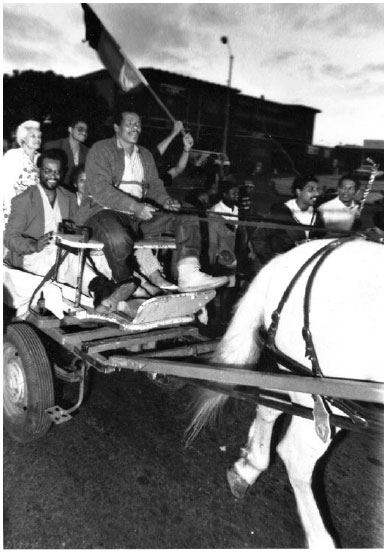
10
A HERO'S WELCOME ON THE CAPE FLATS
(Photo: Benny Gool)
Benny Gool took this photograph on the 21 February 1991 on the day of my release from Robben Island. It was taken after we were processed at Cowley House. We were driven by horse cart along Bonteheuwel Ring Road on the Cape Flats. Seated behind me on the white horse-drawn cart is Mrs Michels and next to her is Quentin Michels. Partially obscured behind the - driver, whose name is Hadji Armien Abdol, is Quentin's eldest sister, Pauline English.
Friends, comrades and well-wishers run alongside the cart holding the tri-colour flag of the ANC of black, green and gold, aloft. I was completely taken aback when we got to Bonteheuwel and found myself driven about on a horse-drawn cart.
11
REFLECTING ON MY EXPERIENCES ON ROBBEN ISLAND FROM AN ELEVATED POSITION OF FREEDOM ON TABLE MOUNTAIN
(Photo: Vincent James)
This photograph, taken a couple of months after my release, was taken of me on Table Mountain by Vincent James from Durban. He was released from Robben Island towards the end of 1990. At the time he was studying at the University of the Western Cape (UWC). At the bottom right of the photograph, just beyond the branches of the trees, lies Sea Point.
I am reclining on a rock as I gaze out at Robben Island, at the centre of the picture, just below the horizon and beyond the cloud. I spent nearly three-and-a-half years there, from 14 August 1987 until 21 February 1991.
The cloud that has shrouded the Island for a very long time has lifted, it was to become a World Heritage Site. From this elevated position, gazing at the Island from a safe distance, my mind drowns in so many varied memories of that windswept dungeon.
* Editors' note: Thanks to Benny Gool for granting permission to publish his photogrpahs in this edition of Kronos.
1 Freedom song with lyrics in Xhosa meaning, 'there's Mkhonto entering'.
2 Xhosa word for flies. The political notes written were in very small legible handwriting because of the scarcity of paper.
3 This fellow admitted after a couple of months to have worked for the security police.
4 Amare - to love belongs to the first conjugation in Latin, i.e. amo, amas, amat, amamus, amatis, amant.
5 Prison Head Quarters.
6 Earlier two other Robben Island inmates, Naledi Tsiki and Ashley Forbes, were taken to Nelson Mandela at Victor Verster Prison.
7 Mandela was removed from Robben Island in 1982 and late in 1986 he was removed to a house that was used for officer accommodation on the grounds of the Victor Verster Maximum Security Prison. I was detained twice in terms of section 10 (this provided for preventative detention) of the then Internal Security Act in 1976 and 1980, and again in 1985 in terms of the Emergency Regulations at Victor Verster Maximum Security Prison.
8 I saw comrade Mandela on a few occasions at Pollsmoor Maximum Security Prison but we were prevented from meeting him formally or speaking to him.
9 Mandela is a teetotaler. The alcoholic beverages were kept for visitors.
10 Lizo Ngqungwana, Quentin Michels, Joe Ngoma, Zed Ncivata, Siseko Macanda, Sazi Veldtman, Douglas Myamya and Cyril Ntabeni joined the SANDF.
11 In the court records my name is spelt Cecil instead of how it appears on my birth certificate as Cecyl. I had used the former spelling until Grade Seven and only changed it when I obtained my birth certificate on which my name was spelt Cecyl. I have use this ever since.
12 I delivered this statement from the dock after being convicted in terms of section 54(1) of the Internal Security Act of 1982. I was accused number 11 in S v L.B. Ngqungwana and 14 others. The accused were Lizo Bright Ngqungwana, Theophilus Mute Mzukwa, Joseph Ngoma, Sazi Veldtman, Douglas Myamya, Joseph Susele Mkhulwa, Anderson Zingisile Ncivata, Nozulu Mabengeza, Quentin Michels, Reed Izwelethu Macozoma, Norman Siseko Macanda, Cyril Ntabeni, Themba Tshibika and Neville van der Rheede.
13 This date is incorrect. The meeting took place in 1972 and Diane Ferrus, a cousin of Hennie, arranged the meeting with about ten members of our political discuss group. They included Roger Schroeder, Martin Arries, Clarence Johnson and Kroneberg.
14 In 1975 I joined Litsoc (Literary Society) led by Andries Walter Oliphant, the Association of Christian Students (ACS) and the Law Students' Society. In 1980 I was elected Vice-Chairperson of the Histosoc (History Society) under the leadership of Isaac Metembo.
15 Some of my fellow detainees were Johnny Issel, Professor Ismail Mohamed, James Matthews, Peter Jones, Julius Landingwe, Alpheus Ndude, Mike Mulligan, Leonardo Appies (SRC President 1976), Pieter Gelderbloem (SRC Treasurer), Tony da Silva (SRC General Secretary), Allan Liebenberg (South African Students'Organisations, SASO) Ismail Moss (SASO), Henry Abrahams (SASO), Henry Ferreira (SASO), Ruben Hare (SASO), Trevor Mopp (SASO), Duncan Roy Whittaker (SASO), Jonas Bosch, Ruben Hudson, Dr Louis van der Poel, and Fred Hufkie Vice-Chairperson of the Eastern Cape Rugby Union and Principal of Spandau High School, Graaff-Reinet.
16 Some of my fellow detainees were Isaac Metembo Histosoc Chairperson and Ebrahim Patel Histosoc executive member and leading member of the Committee of 81. Other members of the Committee of 81 were Zunaid Dharsey, Patrick Rickettes, Riedewaan Adams and Ridewaan Craayenstein.
17 The Churches' Urban Planning Commission (CUPC) was based in Hanover Park on the Cape Flats. At the time it was led by Des Adendorff. Other staff members were Ann Tomlinson (Ntebe), Nabs Wessels, Johnny Issel, Alan Roberts, Bertha Kerchoff and Nomathemba Mfeketo.
18 I was arrested with Peter Orian.
19 There is no Middle Road by Joe Slovo, Time Longer than Rope by Eddie Roux, the occasional Sechaba - a journal of the then banned African National Congress, etc.
20 It is not a shame if a rebellion fails, however it is a shame if a generation passes without rebelling.
21 From the Manifesto of Mkhonto we Sizwe the military wing of the then banned African National Congress, 1961.













